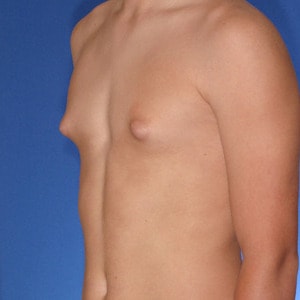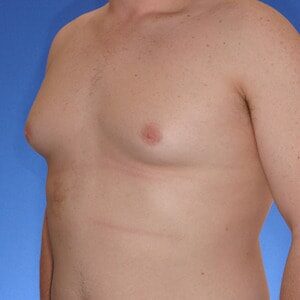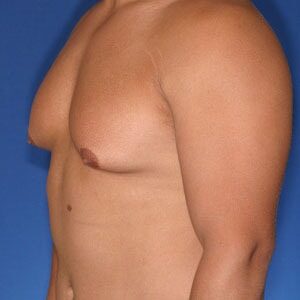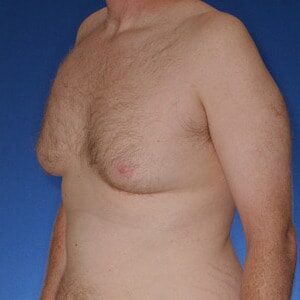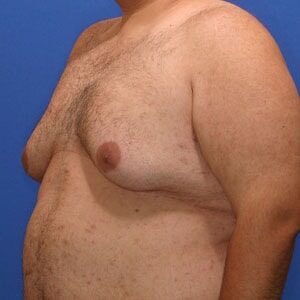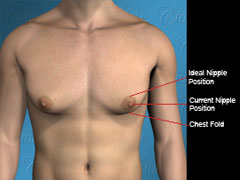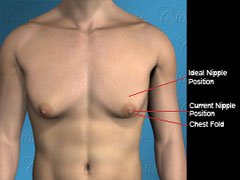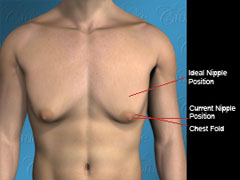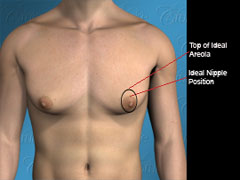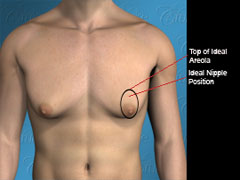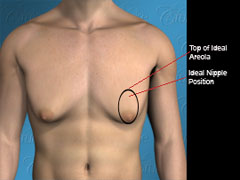Saggy gynecomastia is another sub-component seen with enlarged male breasts. We have discussed different types of gynecomastia based on the possible reasons for male breast enlargement, but there still lies another problem, which is important to be aware of and to understand. Saggy gynecomastia is when a patient has significant excess skin causing the areola and nipple to drop downward and sit on the lower portion of the chest. This type of gynecomastia isn’t as common, because it is typically only seen in patients who have experienced significant weight loss.
As you may recall, there are 3 main causes of gynecomastia:
- Excess breast tissue
- Excess fat
- Excess skin
Excess skin introduces a higher level of complexity when it comes to gynecomastia surgery, because skin must be removed. In order for this to be done properly, a donut shaped incision is made around the entire areola, followed by removal of excess skin from above and sometimes below the areola. This procedure raises the nipple/areola and also tightens the skin. See how this is done in the pictures below:
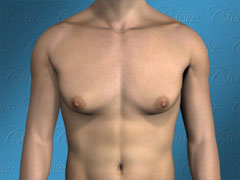
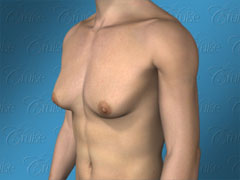
Mild Saggy Gynecomastia
Notice the nipples are no longer facing forward. They have dropped closer to the chest fold
With an “ideal” chest, the nipple usually sits 4-6 cm above the chest fold. When Saggy Gynecomastia is present, the nipple drops down near the chest fold and can even go below this fold in very severe cases. As men age or if they have poor skin quality, mild to moderate cases of Saggy Gynecomastia will usually be seen. The more severe cases are usually present after massive weight loss. This is especially with gastric bypass or Lap Band surgery.
When mild saggy gynecomastia is present, the nipples may be between 2-3 cm above the chest fold. Younger patients have better odds that the skin will snap back after the excess volume is removed. With older men, loss of skin elasticity can compromise the ability for the skin to tighten to the degree one would like to see. Skin quality is the main issue here. The key is determining if the skin should be removed through a donut incision with mild gynecomastia cases.
Dr. Cruise prefers to not to perform the donut incision on his younger patients with mild saggy gynecomastia. They usually don’t need it, because their skin will tighten on it’s own. It is key that a patient commits to wearing a compression garment following surgery to ensure the best result possible. In most older patients, a donut lift may be optimal, but this will depend on the outcome the patient desires from surgery. If the donut incision is recommended, the good news is that the incision is very small and typically does not leave a scar that can be detected. By performing the donut lift, the nipple and areola are moved back into the ideal position and the redundant skin is tightened. This creates a more youthful appearance of the chest. Even though Dr. Cruise will give his recommendation, ultimately the decision to have a donut lift is up to the patient. Being well informed of what the results will be with and without the donut lift is key to making the best decision possible.
The 3 types of Saggy Gynecomastia are determined by the position of the nipple/areola. In mild cases the nipples are typically located 2-3cm above the chest fold. In moderate cases the nipples are located between the chest fold and approximately 2 cm above it. And, with severe cases of saggy gynecomastia, the nipples hang below the chest fold. With moderate sagginess, a donut lift is usually recommend in order to properly reposition the nipple/areola and to tighten the relaxed chest skin.
When a donut lift is a performed there is a “purse string” affect that takes place. Imagine the suture as a purse string. Now imagine you want to close or tighten the closure of your purse. You would see some rippling around the edges of where the purse closed up. This same thing takes place when the sutures are tightened/closed around the areola on the circle or donut shape. If rippling occurs, it will subside within a few months and flatten out in most cases, depending on what degree of sag was present. With mild sagginess, there could be a minimal amount of rippling, but it will go away quickly. With moderate sagginess, there will usually be some degree of rippling, however it will resolve over time. Patience is key during this healing process. The incision placement of a donut lift falls within the margin of the darker colored areola, thus allowing them to be very well hidden.
Severe Gynecomastia is not always treatable with a donut lift alone. The donut lift in these cases is much larger in size, which can cause persistent rippling, especially if the procedure is performed by a surgeon with little experience. To avoid the potential for long-term rippling, most plastic surgeons will use the same approach as they would a female breast lift by performing a full breast lift. A full breast lift requires an anchor type incision that goes around the areola, down the middle of the breast to the chest fold, and then horizontal within the chest fold.
Dr. Cruise believes most men are not comfortable with the extensive incisions associated with a full breast lift. Therefore, he traditionally performs the largest donut lift as safely possible based on his significant experience performing gynecomastia surgery. If a patient still has remaining excess skin 6 months or so following the surgery, Dr. Cruise will advise a secondary skin tightening procedure to correct it. In these cases he performs only the horizontal incision located within the chest fold, avoiding the vertical scar down the middle of the breast. Again, seldom do patients have severe cases of saggy gynecomastia, as it is typically seen after massive weight loss.

